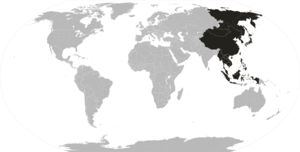The Far East
| Far East | |||||||||||||||||

Location of the Far East, geographically defined
|
|||||||||||||||||
| Chinese name | |||||||||||||||||
|---|---|---|---|---|---|---|---|---|---|---|---|---|---|---|---|---|---|
| Traditional Chinese | 遠東 | ||||||||||||||||
| Simplified Chinese | 远东 | ||||||||||||||||
| Literal meaning | Far East | ||||||||||||||||
|
|||||||||||||||||
| Burmese name | |||||||||||||||||
| Burmese | အရှေ့ဖျား ဒေသ | ||||||||||||||||
| IPA | [ʔəʃḛbjá dèθa̰] | ||||||||||||||||
| Vietnamese name | |||||||||||||||||
| Vietnamese alphabet | Viễn Đông | ||||||||||||||||
| Chữ Hán | |||||||||||||||||
| Thai name | |||||||||||||||||
| Thai | ตะวันออกไกล Tawan-oak klai |
||||||||||||||||
| Korean name | |||||||||||||||||
| Hangul | 극동 | ||||||||||||||||
| Hanja | 極東 | ||||||||||||||||
|
|||||||||||||||||
| Mongolian name | |||||||||||||||||
| Mongolian | Als Dornod | ||||||||||||||||
| Japanese name | |||||||||||||||||
| Kanji | 極東 | ||||||||||||||||
|
|||||||||||||||||
| Malay name | |||||||||||||||||
| Malay | تيمور جاوء Timur Jauh |
||||||||||||||||
| Indonesian name | |||||||||||||||||
| Indonesian | Timur Jauh | ||||||||||||||||
| Filipino name | |||||||||||||||||
| Tagalog | Silanganan (poetic) Malayong Silangan (literal) |
||||||||||||||||
| Portuguese name | |||||||||||||||||
| Portuguese | Extremo Oriente | ||||||||||||||||
| Russian name | |||||||||||||||||
| Russian | Дальний Восток IPA: [ˈdalʲnʲɪj vɐˈstok] |
||||||||||||||||
| Romanization | Dál'niy Vostók | ||||||||||||||||
| Transcriptions | |
|---|---|
| Standard Mandarin | |
| Hanyu Pinyin | Yuǎn Dōng |
| Tongyong Pinyin | Yuǎn Dōng |
| Yue: Cantonese | |
| Jyutping | Yuen5 Dong1 |
| Southern Min | |
| Hokkien POJ | Óan-tong |
| Transcriptions | |
|---|---|
| Revised Romanization | Geuk Dong |
| McCune–Reischauer | Kŭk Tong |
| Transcriptions | |
|---|---|
| Romanization | Kyoku Tō |
The Far East is an alternate geographical term in English (with equivalents in many other languages – see the infobox on the right for examples), that usually refers to East Asia (including Northeast Asia), the Russian Far East (part of North Asia), and Southeast Asia.South Asia is sometimes also included for economic and cultural reasons.
Since the 1960s, East Asia has become the most common term for the region in international mass media outlets. Far East is often deprecated as archaic and Eurocentric, along with the terms "Near East" and "Middle East".
The term Far East came into use in European geopolitical discourse in the 12th century, denoting the Far East as the "farthest" of the three "easts", beyond the Near East and the Middle East. For the same reason, Chinese people in the 19th and early 20th centuries called Western countries "Tàixī (泰西)"—i.e. anything further west than the Arab world.
Prior to the colonial era, "Far East" referred to anything further east than the Middle East. In the 16th century, King John III of Portugal called India a "rich and interesting country in the Far East (Extremo Oriente)." The term was popularized during the period of the British Empire as a blanket term for lands to the east of British India.
...
Wikipedia
